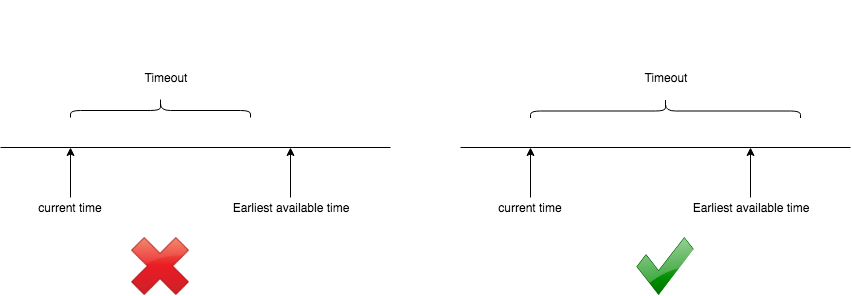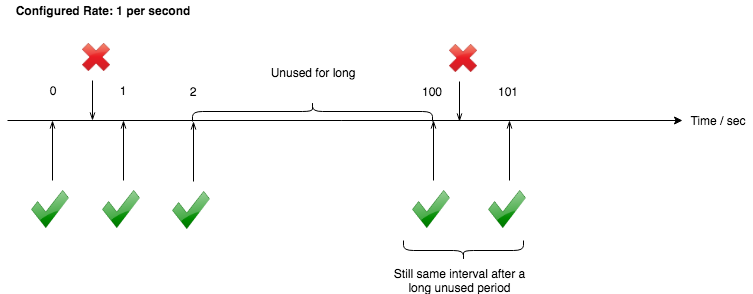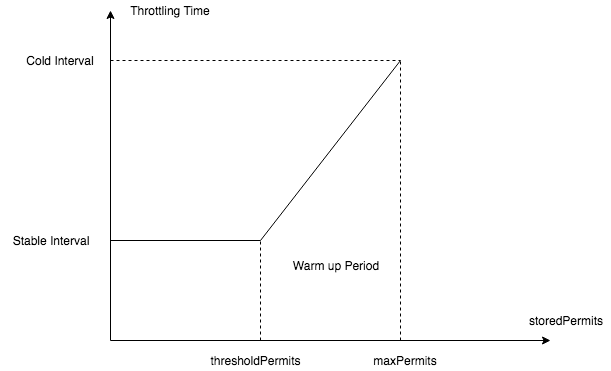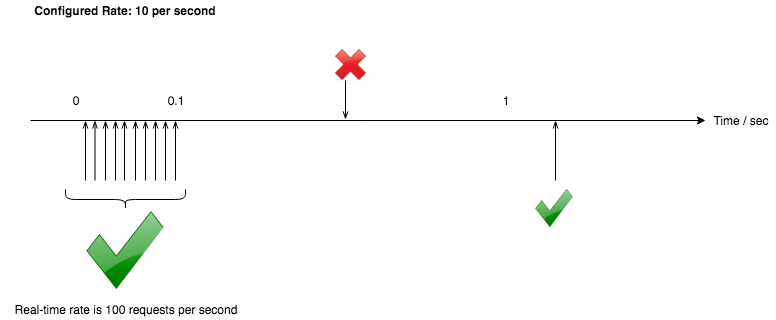Overview
In previous pos, we learned some rate limiting algorithms. In this article, we will see how rate limiting is implemented in Google Guava library.
RateLimiter
RateLimiter class is the base class for all types of rate limiters. Currently
Guava only has two implementations: SmoothWarmingUp and SmoothBursty.
Static Creators Methods
RateLimiter provides two static creators that will create a SmoothBursty
rate limiter and a SmoothWarmingUp rate limiter respectively. We will talk
about these two rate limiters later.
static RateLimiter create(double permitsPerSecond)
static RateLimiter create(double permitsPerSecond, long warmupPeriod, TimeUnit unit)
The time unit for the configured rate is per second. If you want to use any other time unit, you have to convert it to permits per second. For example, 1 permit per minute equals to 1 / 60 permits per second.
Concurrency
RateLimiter class takes care of multi-thread access to methods by using a
mutex.
@MonotonicNonNull private volatile Object mutexDoNotUseDirectly;
private Object mutex() {
Object mutex = mutexDoNotUseDirectly;
if (mutex == null) {
synchronized (this) {
mutex = mutexDoNotUseDirectly;
if (mutex == null) {
mutexDoNotUseDirectly = mutex = new Object();
}
}
}
return mutex;
}
In each method, syschronized(mutex()) is called around operations, including
invocation to abstract methods implemented by subclasses so that they don’t need
to worry about concurrency.
Think: why it uses two if statements to check the mutex value?
Abstract Methods
Everything else is taken care by the base class RateLimiter so that a subclass
only has to implement the following four methods:
abstract void doSetRate(double permitsPerSecond, long nowMicros);
abstract double doGetRate();
abstract long queryEarliestAvailable(long nowMicros);
abstract long reserveEarliestAvailable(int permits, long nowMicros);
The first two methods are straightforward and they imply that a user can change the rate at runtime.
queryEarliestAvailable
queryEarliestAvailable takes current time and returns the earliest available
time of next permit. It is called when checking whether a permit can be granted
with certain timeout:
private boolean canAcquire(long nowMicros, long timeoutMicros) {
return queryEarliestAvailable(nowMicros) - timeoutMicros <= nowMicros;
}
Personally I think this method will be easier to understand if the return statement
is changed to: nowMicros + timeoutMicros >= queryEarliestAvailable(nowMicros),
which means return true if and only if we can pass the earliest available time
of next permit after waiting for at most timeout microseconds from now on.

reserveEarliestAvailable
reserveEarliestAvailable reserves the requested number of permits and returns
the earliest time when all permits are available. This method is called to
calculate the duration that the caller has to wait before getting all permits.
reserveAndGetWaitLength is the method used to calculate the time to wait by
calling reserveEarliestAvailable.
final long reserveAndGetWaitLength(int permits, long nowMicros) {
long momentAvailable = reserveEarliestAvailable(permits, nowMicros);
return max(momentAvailable - nowMicros, 0);
}
SleepingStopwatch
RateLimiter depends on a SleepingStopwatch to mesure the time elapsed since
start as well as sleep the thread whenever needed.
abstract static class SleepingStopwatch {
protected abstract long readMicros(); // Return time elpsed since start
protected abstract void sleepMicrosUninterruptibly(long micros); // Sleep
}
This class also provides a static creator method which creates an implementation
with the help of another two classes in Guava: Stopwatch and
Uninterruptibles.
tryAcquire and acquire
tryAcquire() and acquire() are the two most important methods, which are
responsible to calculate the throttling time and sleep for that long.
tryAcquire
tryAcquire() has four overload methods, but all of them finally call to the
following one:
public boolean tryAcquire(int permits, long timeout, TimeUnit unit) {
long timeoutMicros = max(unit.toMicros(timeout), 0);
checkPermits(permits); // Parameter validation
long microsToWait;
synchronized (mutex()) {
long nowMicros = stopwatch.readMicros();
if (!canAcquire(nowMicros, timeoutMicros)) {
return false;
} else {
microsToWait = reserveAndGetWaitLength(permits, nowMicros);
}
}
stopwatch.sleepMicrosUninterruptibly(microsToWait);
return true;
}
The method first calls canAcquire to check whether the requested permits can
be acquired within the timeout value specified by the user. If not then it
directly returns false. Otherwise it calculates the time it needs to wait and
sleeps for that long before returning true.
acquire
acquire() has two overload methods and they finally call to the following one:
public double acquire(int permits) {
long microsToWait = reserve(permits);
stopwatch.sleepMicrosUninterruptibly(microsToWait);
return 1.0 * microsToWait / SECONDS.toMicros(1L);
}
Different from tryAcquire(), acquire() will block until all requested
permits can be granted. It returns the time spent sleeping in seconds.
SmoothRateLimiter
SmoothRateLimiter is a subclass of RateLimiter and the superclass of
SmoothWarmingUp and SmoothBursty.
Design
The design is based on leaky bucket algorithm. But it also borrows some ideas from token bucket.
One problem of native leaky bucket algorithm is, it doesn’t keep the memory of past underutilization - when lots of water drops after the bucket being empty for long, it still leaks at the same constant rate as usual.

To deal with the underutilization problem, a storedPermits is used to model
the past underutilization. Specifically, this variable is 0 when there is no
underutilization and it is increased by 1 every second that the rate limiter is
unused. It can grow up to maxPermits. Requested permits are first served by
the storedPermits and then served by fresh permits. When storedPermits is 3
and acquire(10) is called, then the first 3 permits are served by
storedPermits while the rest 7 permits are served by fresh permits.
Now the question is, when we serve the permits using storedPermits, how to
calculate the time to wait? When there is no underutilization, the interval
between requests should be 1 / rate. When a user requests n permits, if they
are all served by fresh permits, the waiting time should be n / rate. But if
the n permits are all or partially served by storedPermits, what should be
the throttling time?
Basically, we need a function that maps storedPermits and permitsToTake to
throttling time. SmoothRateLimiter defines an abstract method
storedPermitsToWaitTime(double storedPermits, double permitsToTake) that needs
to be implemented by the subclasses to play this role.
Another abstract method is coolDownIntervalMicros() which returns the interval
between two increments of storedPermits when the rate limiter is unused. In
other words, it measures how fast we cumulate the storedPermits. For example,
if it returns 10^6 microseconds (1 second), then we increase storedPermits
by 1 every second. The return value can be same as or different from the stable
interval. Actually it is the same as stable interval in SmoothBursty
implementation but different from stable interval in SmoothWarmingUp
implementation. We will talk about that later.
Implementation
Variables
A SmoothRateLimiter has four member variables:
storedPermits- used to model past underutilization as described in Design section.maxPermits- maximum number ofstoredPermits.stableIntervalMicros- the interval between two requests at the stable rate. Its value should be1 / rate.nextFreeTicketMicros- the time when next permit can be granted. It is updated after each permit is granted.
rsync
resync() method updates the value of nextFreeTicketMicros and
storedPermits if nextFreeTicketMicros is in the past.
void resync(long nowMicros) {
// if nextFreeTicket is in the past, resync to now
if (nowMicros > nextFreeTicketMicros) {
double newPermits = (nowMicros - nextFreeTicketMicros) / coolDownIntervalMicros();
storedPermits = min(maxPermits, storedPermits + newPermits);
nextFreeTicketMicros = nowMicros;
}
}
Here we see that it calls subclass’s coolDownIntervalMicros() to determine how
many permits we need to add to storedPermits. This is similar to lazily
refilled tokens in token bucket algorithm we discussed in previous
article.
resync() is called before reserving permits. See reserveEarliestAvailable
below.
Override Methods
Since SmoothRateLimiter is a subclass of RateLimiter, it needs to implement
the abstract methods. As we mentioned earlier, two most important ones are
queryEarliestAvailable and reserveEarliestAvailable.
Apparently, queryEarliestAvailable just needs to return nextFreeTicketMicros
variable.
@Override
final long queryEarliestAvailable(long nowMicros) {
return nextFreeTicketMicros;
}
reserveEarliestAvailable also returns current nextFreeTicketMicros. But
it also needs to update nextFreeTicketMicros to a new value.
@Override
final long reserveEarliestAvailable(int requiredPermits, long nowMicros) {
resync(nowMicros);
long returnValue = nextFreeTicketMicros;
double storedPermitsToSpend = min(requiredPermits, this.storedPermits);
double freshPermits = requiredPermits - storedPermitsToSpend;
long waitMicros =
storedPermitsToWaitTime(this.storedPermits, storedPermitsToSpend)
+ (long) (freshPermits * stableIntervalMicros);
this.nextFreeTicketMicros = LongMath.saturatedAdd(nextFreeTicketMicros, waitMicros);
this.storedPermits -= storedPermitsToSpend;
return returnValue;
}
This method first saves the old nextFreeTicketMicros to be the return value.
Then it calculates how many stored permits and how many fresh permits will be
used to serve this the required permits. The waiting time incurred by the stored
permits is gotten from storedPermitsToWaitTime implemented by the subclass
while the waiting time incurred by the fresh permits is just freshPermits *
stableInterval. The total waiting time is the sum of these two value and is
added to nextFreeTicketMicros, which means next request will have to wait for
at most that long before being granted.
SmoothBursty
SmoothBursty implementation is very straightforward -
storedPermitsToWaitTime simply returns 0, meaning that storedPermits are
translated to zero throttling. That’s why it’s called “bursty”.
@Override
long storedPermitsToWaitTime(double storedPermits, double permitsToTake) {
return 0L;
}
coolDownIntervalMicros simply returns stableIntervalMicros, meaning that
storedPermits cumulates at the stable rate while unused.
@Override
double coolDownIntervalMicros() {
return stableIntervalMicros;
}
SmoothBursty has a member variable maxBurstSeconds that is used to calculate
maxPermits.
maxPermits = maxBurstSeconds * permitsPerSecond;
By default maxBurstSeconds is 1 and there is no way for the user to change its
value.
SmoothWarmingUp
To understand how SmoothWarmingUp rate limiter converts storedPermits to
throttling time, let’s first look at the following figure:

The x-axis is storedPermits and the y-axis is the throttling interval.
Suppose there is a vertical line x = k representing the state of the rate
limiter:
- When the rate limiter is fully used, the line stays at
x = 0. - When the rate limiter is unused, the line goes from left to right.
- When the rate limiter is used again after an underutilization, the line goes from right to left.
The trapezoid in the figure denotes a warm up period. When a SmoothWarmingUp
rate limiter is reused after an underutilization, it is said to be in a warm up
period until storedPermits reaches thresholdPermits. In the warm up period,
the throttling interval is longer than stable interval, which means the rate
limiter becomes slower after a period of underutilization. Warm up period
duration can be specified by the user.
How to decide the value of thresholdPermits and maxPermits? In the comment,
they claim that to preserve the behavior of original implementation, the time it
takes to go from thresholdPermits to 0 has to be half the time it takes to go
from maxPermits to thresholdPermits, which is the warmUpPeriod. In other
words, in the figure above, the area of the trapezoid is two times the area of
the rectangle. Therefore, to calculate thresholdPermits:
warmupPeriod = 2 * stableInterval * thresholdPermits
thresholdPermits = 0.5 * warmupPeriod / stableInterval
warmupPeriod is specified by the user while creating this rate limiter.
To calculate maxPermits:
warmupPeriod
= 0.5 * (stableInterval + coldInterval) * (maxPermits - thresholdPermits)
maxPermits
= thresholdPermits + 2.0 * warmupPeriod / (stableInterval + coldInterval)
coldInterval is the maximum throttling interval, which is calculated by a
parameter coldFactor that has a default value 3.0 and is not modifiable by
the user.
coldInterval = stableInterval * coldFactor;
coolDownIntervalMicros
@Override
double coolDownIntervalMicros() {
return warmupPeriodMicros / maxPermits;
}
As we mentioned before, coolDownIntervalMicros is the interval between two
increments of storedPermits. In the figure above, it measures how fast our
imaginary vertical line goes from left to right. This value is chose to be
warmupPeriod / maxPermits so that the time it takes to go from 0 to
maxPermits is equal to warmupPeriod.
storedPermitsToWaitTime
Suppose currently there are K storedPermits and we request P permits (P <= K).
Then the total throttling time should be the area between x = K and x = K -
P.

Thus, storedPermitsToWaitTime just needs to calculate this area.
@Override
long storedPermitsToWaitTime(double storedPermits, double permitsToTake) {
double availablePermitsAboveThreshold = storedPermits - thresholdPermits;
long micros = 0;
// measuring the integral on the right part of the function (the climbing line)
if (availablePermitsAboveThreshold > 0.0) {
double permitsAboveThresholdToTake = min(availablePermitsAboveThreshold, permitsToTake);
double length =
permitsToTime(availablePermitsAboveThreshold)
+ permitsToTime(availablePermitsAboveThreshold - permitsAboveThresholdToTake);
micros = (long) (permitsAboveThresholdToTake * length / 2.0);
permitsToTake -= permitsAboveThresholdToTake;
}
// measuring the integral on the left part of the function (the horizontal line)
micros += (long) (stableIntervalMicros * permitsToTake);
return micros;
}
It first checks whether storedPermits is above the threshold. If so, then we
need to calculate the area of the trapezoid. Otherwise we only need to calculate
the partial area of the rectangle. permitsToTime is used to query “given x,
what is the y value of the climbing line?”
private double permitsToTime(double permits) {
return stableIntervalMicros + permits * slope;
}
The value of slope should be (coldInterval - stableInterval) / (maxPermits -
thresholdPermits).
Problem
After understanding the implementation, we can find one problem - when we only
request 1 permit at a time, the SmoothRateLimiter works as a leaky bucket with
consideration of past underutilization. However, if we request many permits at a
time, it has the same problem as token bucket. That is, the real-time rate might
be higher than the configured rate. And it may starve following requests.

This is because the throttling time is paid by next request instead of current request. And larger requests push next available time further than smaller requests. For example, suppose the rate is 1 per seconds. If we request 100 permits at the beginning, the permits will be granted right away but the next request needs to wait for at most 100 seconds. Since most of the use cases I have seen only require to request 1 permit at a time, I am not sure whether this is a serious problem. But you may need to keep it in mind while requesting many requests at a time.
